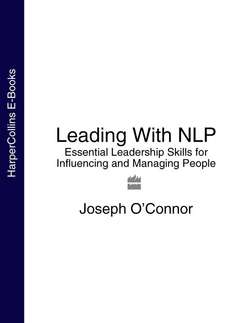Читать книгу Leading With NLP: Essential Leadership Skills for Influencing and Managing People - Joseph O’Connor - Страница 11
Exploring Mental Perspectives I: Vision
ОглавлениеIt seems natural to represent time as distance in our minds. We talk of events ‘far in the future’ or ‘close to the present’ and the law of perspective operates in our minds as well as in the outside world. The longer a goal takes to achieve, the further away we represent it, and the further away, the smaller it seems. The smaller it seems, the less motivating and the less real it may feel, so why bother to start? Perspective is governed by an inverse square law. In other words, if you retreat to twice the distance from an object, it does not seem to become half the size, it becomes a quarter of the size – the size varies as a square of the distance. So the attraction a goal has for you will vary tremendously depending on whereabouts you put it in your mental field. A small distance can make a big difference.
Try this thought experiment. Think of something important you want to achieve in your personal or professional life. Imagine it in your mind. Make a picture of it.
Whereabouts in space is your mental picture? For example, it may be directly in front of you or to one side. You may be looking up at it or down on it.
How far away is it? Is it within arm’s reach or further?
How long do you expect it will take to achieve?
Experiment by moving it further away. How do you feel about it now?
Does it seem more or less attractive?
Does it get smaller, larger or stay the same size as you move it further away?
Does the distance correspond to how much time you think it will take to achieve it?
Does it seem as though the further away it is, the further in the future it is?
Move it so far away that you can hardly see it. How do you feel about it now? Still motivated?
Now move it closer.
How does that change it?
Does it seem more attractive?
Does it get bigger, smaller or stay the same as you move it towards you?
Does it seem more achievable? Does it seem that you will get it any sooner?
How do you feel about it?
Explore whether you experience a threshold effect – a point beyond which your picture loses any attraction. Also find the point where it is ‘too close for comfort.’
Move your picture back to the most comfortable distance. Was that where it started?
Play with these distances. You will find them interesting. If a goal ever seems unrealistic or not attractive enough it may be too far away. The further away, the less clearly you can see it.
When you plan your goal, begin by making a picture close to you and then move it to a suitable distance. Any time you need to ‘get in touch’ with it again, pull it closer.
Leaders make their goal seem possible however far into the future it may be. One way to do this is to create a sense of movement, for example:
‘The day is approaching …’
‘We can reach out and grasp …’
‘Hitting a moving target …’
‘We can reach it together …’
‘It’s within arm’s length …’
‘Headlong into the future …’
‘Nothing can stop us …’
